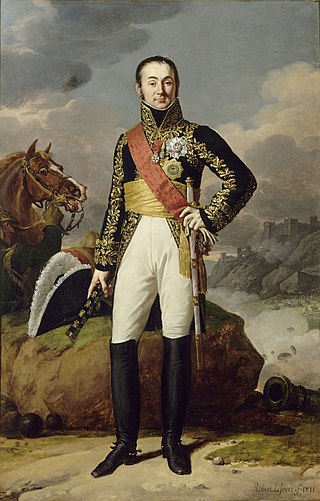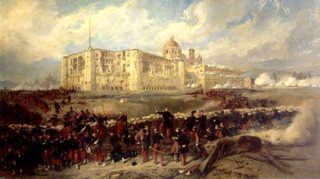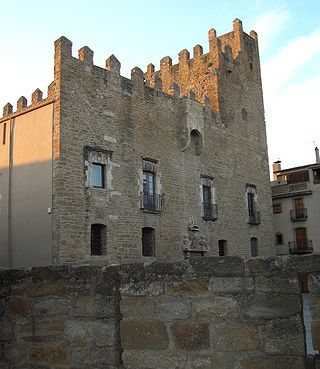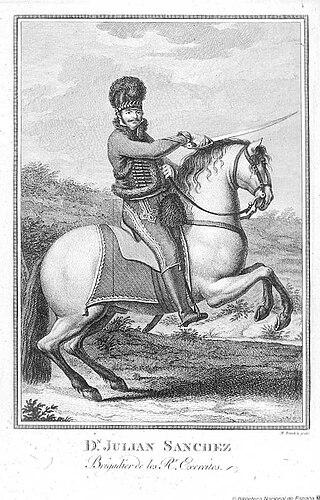| |||||
| Decades: | |||||
|---|---|---|---|---|---|
| See also: | Other events of 1810 List of years in Spain | ||||
| |||||
| Decades: | |||||
|---|---|---|---|---|---|
| See also: | Other events of 1810 List of years in Spain | ||||

At the Battle of Fuentes de Oñoro, the Anglo-Portuguese Army under Wellington checked an attempt by the French Army of Portugal under Marshal André Masséna to relieve the besieged city of Almeida.

At the Battle of Vitoria, a British, Portuguese and Spanish army under the Marquess of Wellington broke the French army under King Joseph Bonaparte and Marshal Jean-Baptiste Jourdan near Vitoria in Spain, eventually leading to victory in the Peninsular War.

Nicolas Charles Oudinot, duc de Reggio, was a French general of the French Revolutionary Wars and the Napoleonic Wars. He is known to have been wounded 34 times in battle, being hit by artillery shells, sabres, and at least twelve bullets over the course of his military career. A Marshal of the Empire, he is best known for his contributions to the Napoleonic Wars with his famous grenadier division. Oudinot is one of the Names inscribed under the Arc de Triomphe, Eastern pillar Columns 13, 14.

Ciudad Rodrigo is a small cathedral city in the province of Salamanca, in western Spain, with a population in 2016 of 12,896. It is also the seat of a judicial district.

The second French intervention in Mexico, also known as the Second Franco-Mexican War (1861–1867), was a military invasion of the Republic of Mexico by the French Empire of Napoleon III, purportedly to force the collection of Mexican debts in conjunction with Great Britain and Spain. Mexican conservatives supported the invasion, since they had been defeated by the liberal government of Benito Juárez in a three-year civil war. Defeated on the battlefield, conservatives sought the aid of France to effect regime change and establish a monarchy in Mexico, a plan that meshed with Napoleon III's plans to re-establish the presence of the French Empire in the Americas. Although the French invasion displaced Juárez's Republican government from the Mexican capital and the monarchy of Archduke Maximilian was established, the Second Mexican Empire collapsed within a few years. Material aid from the United States, whose four-year civil war ended in 1865, invigorated the Republican fight against the regime of Maximilian, and the 1866 decision of Napoleon III to withdraw military support for Maximilian's regime accelerated the monarchy's collapse. Maximilian and two Mexican generals were executed by firing squad on 19 June 1867, ending this period of Mexican history.

In the siege of Badajoz, also called the third siege of Badajoz, an Anglo-Portuguese Army under the command of the Arthur Wellesley, the Earl of Wellington besieged Badajoz, Spain, and forced the surrender of the French garrison. The siege was one of the bloodiest in the Napoleonic Wars and was considered a costly victory by the British, with some 4,800 Allied soldiers killed or wounded in a few short hours of intense fighting during the storming of the breaches as the siege drew to an end. Enraged at the huge number of casualties they suffered in seizing the city, the troops broke into houses and stores consuming vast quantities of alcohol with many of them then going on a rampage, threatening their officers and ignoring their commands to desist, and even killing several. It took three days before the men were brought back into order. When order was restored, an estimated 200–300 civilians had been killed or injured.

Louis Henri Loison briefly joined the French Army in 1787 and after the French Revolution became a junior officer. Blessed with military talent and courage, he rapidly rose to general officer rank during the French Revolutionary Wars. He got into difficulties because of his fondness for plundering. In late 1795 he helped Napoleon Bonaparte crush a revolt against the government. After a hiatus, he returned in 1799 to fight in Switzerland where he earned another promotion. In 1800 he commanded a division under Napoleon in the Marengo campaign.

In the siege of Almeida, Portugal, the French corps of Marshal Michel Ney captured the border fortress from Brigadier General William Cox's Portuguese garrison. This action was fought in the summer of 1810 during the Peninsular War portion of the Napoleonic Wars. Almeida is located in eastern Portugal, near the border with Spain.

In the Battle of Alba de Tormes on 28 November 1809, an Imperial French corps commanded by François Étienne de Kellermann attacked a Spanish army led by Diego de Cañas y Portocarrero, Duke del Parque. Finding the Spanish army in the midst of crossing the Tormes River, Kellermann did not wait for his infantry under Jean Gabriel Marchand to arrive, but led the French cavalry in a series of charges that routed the Spanish units on the near bank with heavy losses. Del Parque's army was forced to take refuge in the mountains that winter. Alba de Tormes is 21 kilometres (13 mi) southeast of Salamanca, Spain. The action occurred during the Peninsular War, part of the Napoleonic Wars.

In the siege of Ciudad Rodrigo, in Salamanca, Spain, the French Marshal Michel Ney took the fortified city from Field Marshal Andrés Pérez de Herrasti on 10 July 1810 after a siege that began on 26 April. Ney's VI Corps made up part of a 65,000-strong army commanded by André Masséna, who was bent on a third French invasion of Portugal.
Events from the year 1810 in France.

The Battle of Blaye of 1593, also known as the Battle of Bec d'Ambès or Battle of the Gironde Estuary, was a naval Spanish victory that took place on 18 April 1593 off Blaye and Bec d'Ambès, Gironde Estuary, France, during the seven-month siege of Blaye between the French-Protestant forces of Henry of Navarre and the French-Catholic garrison of the city led by Governor Jean-Paul d'Esparbès de Lussan d'Aubeterre, in the context of the Brittany Campaign during the French Wars of Religion and the Anglo-Spanish War (1585–1604).
The Combat of Barquilla was a minor skirmish between British and French forces two days after the siege of Ciudad Rodrigo, in which Robert Craufurd attacked French grenadiers covering a foraging party. The French grenadiers, formed in a single square, made a fighting withdrawal, fending off British cavalry and escaping unscathed.

In the Battle of La Bisbal on 14 September 1810 a Spanish division led by Henry O'Donnell and supported by an Anglo-Spanish naval squadron led by Francis William Fane and Charles William Doyle surprised an Imperial French brigade commanded by François Xavier de Schwarz. The Imperial troops were from the Confederation of the Rhine, a collection of small German states that were allied to Napoleon. Part of a division led by Marie François Rouyer, Schwarz's brigade was almost completely wiped out, most of its soldiers being taken prisoner along with its commander. One of the few Allied casualties was the capable O'Donnell, wounded in the foot. The battle occurred during the Peninsular War, part of the Napoleonic Wars.
Gaspar Domingo de Mendoza y Delgado was a Spanish soldier in the War of the Spanish Succession. He later served as the Spanish colonial governor of Santa Fe de Nuevo México province from 1739 to 1743, located in the northern Viceroyalty of New Spain.

The fortress of Real Fuerte de la Concepción is a star fortress built in the Vaubanesque style. It is located 0.6 miles (0.97 km) west of the village of Aldea del Obispo in the province of Salamanca, western Spain, part of the autonomous community of Castile and León. The fortress was constructed there because of its position of great strategic significance due to its proximity to the border between Spain and Portugal which lies 0.4 miles (0.64 km) to the west of the fortress. The Fortress of the Concepcion is also opposite the Portuguese castle fortress of Almeida which lies 5.5 miles (8.9 km) west-north-west of the fortress. In 2006, the derelict fortress was sold privately and the site was renovated into a luxury hotel which opened in 2012.

Andrés Pérez de Herrasti y Pérez del Pulgar (1750–1818) was a Spanish military commander.
Ramón Blanco Criado (1763–1821) was a Spanish military commander.

Julián Sánchez García (1774–1832), nicknamed El Charro or Don Julián, was a Spanish guerrillero and military commander.